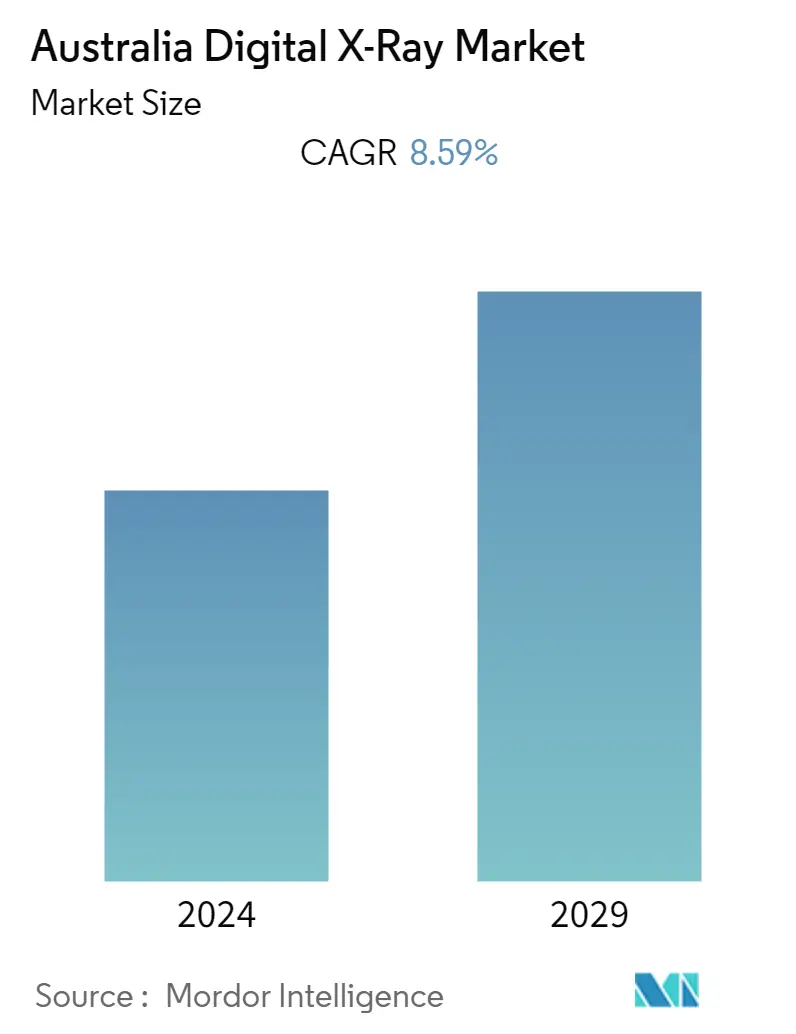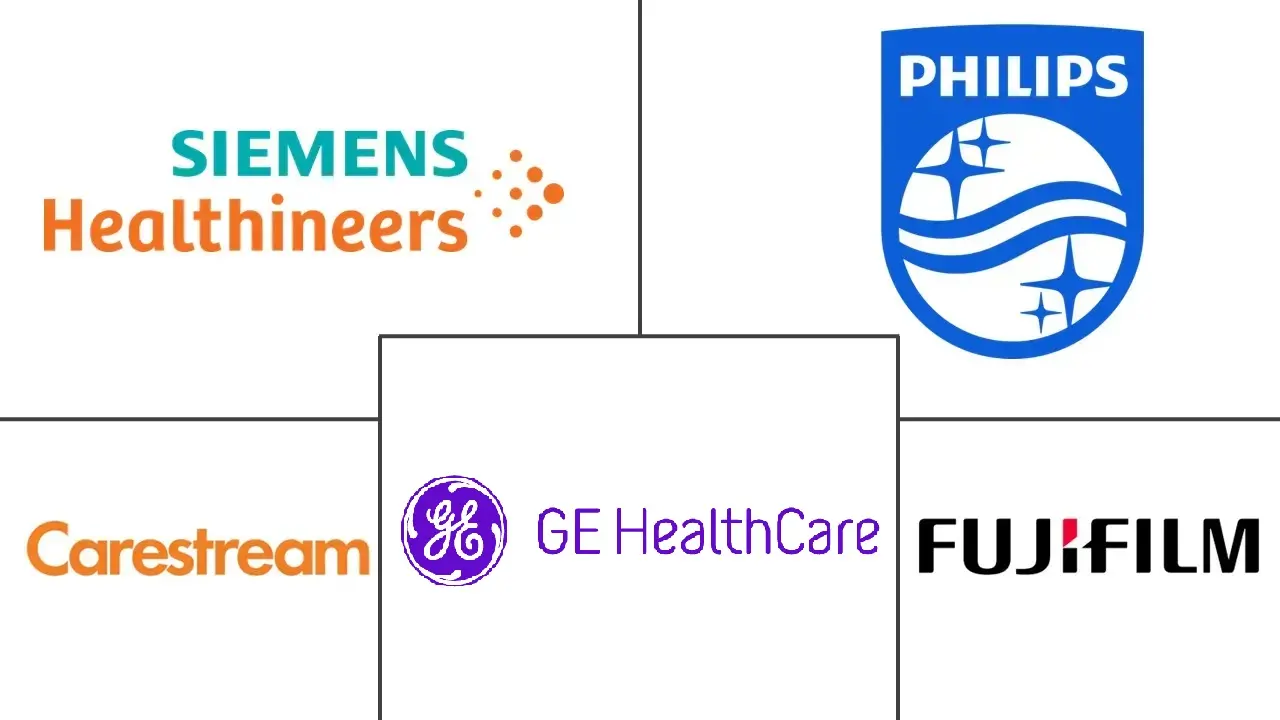Market Size of Australia Digital X-Ray Industry

| Study Period | 2019 - 2029 |
| Base Year For Estimation | 2023 |
| Forecast Data Period | 2024 - 2029 |
| Historical Data Period | 2019 - 2022 |
| CAGR | 8.59 % |
| Market Concentration | Medium |
Major Players
*Disclaimer: Major Players sorted in no particular order |
Australia Digital X-Ray Market Analysis
The Australia Digital X-Ray Market size is estimated at USD 226.40 million in 2023 and is expected to reach USD 341.84 million by 2028, growing at a CAGR of 8.59% during the forecast period.
The COVID-19 pandemic resulted in disruptions to the supply chain, delayed installations, reduced services and financial challenges for healthcare providers, which impacted the digital X-ray market in Australia. For instance, according to an article published by MDPI in January 2023, the availability of diagnostic tests, such as diagnostic imaging, both clinically and based on research, for conditions unrelated to cancer impacted diagnostics during the pandemic. In Australia, the first wave of the COVID-19 pandemic was associated with a significant reduction in total available imaging services, with general radiology, ultrasound, and magnetic resonance imaging (MRI) services. Hence, there was a decrease in digital X-ray demand during the initial phase of the pandemic. However, currently, as there is better access to healthcare facilities compared to the initial pandemic phase due to the lockdown, the market is expected to gain its growth pace in the post-pandemic period.
Factors such as the increasing prevalence of chronic diseases are expected to drive market growth. Chronic diseases such as cardiovascular disease, respiratory disease, and neurological conditions often require regular imaging for diagnosis, treatment planning, and monitoring of disease progression. As the prevalence of chronic diseases continues to rise, the demand for efficient and effective diagnostic tools like digital X-ray systems will increase. For instance, according to the Australian Institute of Health and Welfare update in February 2023, indigenous Australians living in remote areas reported higher rates of cardiovascular disease, with 18%, compared with those in non-remote areas, which is 15%. Across jurisdictions, Indigenous Australians reporting cardiovascular disease ranged between 13% in South Australia and 18% in the Northern Territory. Thus, with a high burden of cardiovascular disease, the demand for its monitoring and diagnosis increases, thereby driving market growth.
Furthermore, the increasing prevalence of cancer is expected to increase the demand for digital X-rays as cancer patients require regular monitoring and diagnosis to track tumour progression. For instance, National Cancer Statistics in December 2021 estimated that 151,000 Australians were diagnosed with cancer in 2021, over 400 per day, and over 1 million Australians live with cancer. Thus, with the high burden of cancer cases, the demand for monitoring cancer progression through digital X-rays increases, driving market growth over the forecast period.
Additionally, the government's initiatives to improve the healthcare infrastructure align with their goals of enhancing healthcare delivery, reducing healthcare costs, and improving patient outcomes. Governments will likely create a favourable environment for digital X-ray market growth by encouraging the transition to digital X-ray systems. For instance, in April 2022, the Australian Government installed four 3D X-ray units at the Melbourne and Sydney international mail gateway facilities. The department received funding for three more 3D X-ray units to be installed. Thus, funding from the government to install 3D X-ray units led to increased accessibility for digital X-rays, thereby driving market growth.
Thus, factors such as the increasing prevalence of chronic diseases and government funding increase are expected to boost market growth over the forecast period. However, the high equipment cost is expected to impede market growth over the forecast period.
Australia Digital X-Ray Industry Segmentation
As per the scope of this report, digital X-ray or digital radiography is a form of X-ray imaging where digital X-ray sensors are used instead of traditional photographic films. This has the added advantage of time efficiency and the ability to transfer images digitally and enhance them for better visibility. This method bypasses the chemical processing of photographic films. Digital X-ray imaging has high demand, as it requires less radiation exposure compared to traditional X-rays. Australia Digital X-Ray Market is Segmented by Application (Orthopedic, Cancer, Dental, Cardiovascular, and Other Applications), Technology (Computed Radiography and Direct Radiography), Portability (Fixed Systems and Portable Systems), and End User (Hospitals, Diagnostic Centers, and Other End Users). The report offers the value (in USD million) for the above segments.
| By Application | |
| Orthopedic | |
| Cancer | |
| Dental | |
| Cardiovascular | |
| Other Applications |
| By Technology | |
| Computed Radiography | |
| Direct Radiography |
| By Portability | |
| Fixed Systems | |
| Portable Systems |
| By End User | |
| Hospitals | |
| Diagnostic Centers | |
| Other End Users |
Australia Digital X-Ray Market Size Summary
The Australia digital X-ray market is poised for significant growth, driven by the increasing prevalence of chronic diseases and cancer, alongside government initiatives to enhance healthcare infrastructure. The market experienced initial setbacks due to the COVID-19 pandemic, which disrupted supply chains and reduced demand for imaging services. However, as healthcare access improves post-pandemic, the market is expected to regain momentum. The rising incidence of chronic conditions such as cardiovascular and respiratory diseases necessitates regular imaging, thereby boosting the demand for digital X-ray systems. Additionally, the growing cancer burden in Australia underscores the need for effective diagnostic tools to monitor disease progression, further propelling market expansion.
Government efforts to improve healthcare delivery and reduce costs are creating a favorable environment for the digital X-ray market. Initiatives such as funding for advanced imaging units and support for cancer diagnosis are expected to drive market growth. The increasing geriatric population, coupled with technological advancements, is also contributing to the demand for digital X-ray systems, particularly in computed radiography. The market is moderately competitive, with key players like Carestream Health, Siemens Healthineers AG, and GE Healthcare actively participating. Overall, the combination of rising disease prevalence, government support, and technological progress is anticipated to sustain the market's growth trajectory over the forecast period.
Australia Digital X-Ray Market Size - Table of Contents
-
1. MARKET DYNAMICS
-
1.1 Market Overview
-
1.2 Market Drivers
-
1.2.1 Increasing Prevalence of Chronic Diseases
-
1.2.2 Technological Advancements
-
-
1.3 Market Restraints
-
1.3.1 High Cost of Procedure and Lack of Skilled Professionals
-
-
1.4 Porter's Five Forces Analysis
-
1.4.1 Threat of New Entrants
-
1.4.2 Bargaining Power of Buyers/Consumers
-
1.4.3 Bargaining Power of Suppliers
-
1.4.4 Threat of Substitute Products
-
1.4.5 Intensity of Competitive Rivalry
-
-
-
2. MARKET SEGMENTATION (Market Size by Value - USD million)
-
2.1 By Application
-
2.1.1 Orthopedic
-
2.1.2 Cancer
-
2.1.3 Dental
-
2.1.4 Cardiovascular
-
2.1.5 Other Applications
-
-
2.2 By Technology
-
2.2.1 Computed Radiography
-
2.2.2 Direct Radiography
-
-
2.3 By Portability
-
2.3.1 Fixed Systems
-
2.3.2 Portable Systems
-
-
2.4 By End User
-
2.4.1 Hospitals
-
2.4.2 Diagnostic Centers
-
2.4.3 Other End Users
-
-
Australia Digital X-Ray Market Size FAQs
What is the current Australia Digital X-Ray Market size?
The Australia Digital X-Ray Market is projected to register a CAGR of 8.59% during the forecast period (2024-2029)
Who are the key players in Australia Digital X-Ray Market?
Carestream Health, GE Healthcare, Siemens Healthineers AG, Fujifilm Holdings Corporation and Koninklijke Philips NV are the major companies operating in the Australia Digital X-Ray Market.

